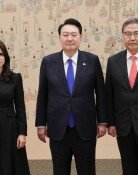N.K.’s missile provocations seen as process to put new weapons to combat mission
N.K.’s missile provocations seen as process to put new weapons to combat mission
Posted May. 13, 2019 08:31,
Updated May. 13, 2019 09:39

South Korea’s Defense Ministry and National Intelligence Service have yet to confirm whether the short-range missiles North Korea fired on May 4 and May 9 in succession are ballistic missiles or not. They indicate that the missiles are new weapons that have never been revealed before, and that they need more thorough analysis.
However, watchers in and outside the South Korean military are tentatively concluding that the missiles are new solid fuel-powered ballistic missiles the North unveiled for the first time at the 70th anniversary of the founding of the North Korean People’s Army in February last year. The South Korean and U.S. intelligence authorities have named the missile “KN-21” and have been closely monitoring the North’s moves for the missile’s development and deployment. It means that after unveiling the missile’s “prototype,” Pyongyang has been improving the missile’s guiding devices and rocket to increase reliability, and introduced the mobile launch vehicle, before pushing to conduct test and live firings of the missile in succession in the presence of North Korean leader Kim Jong Un.
“It is quite unusual that Defense Commission Chairman Kim Jong Un inspected in person the launch sites of the same missile successively twice within several days,” a South Korean military source said. “Chairman Kim is believed to have given related instructions, including the specific timeline to put the missile to combat mission, in advance.” It means that the North Korean leader most likely urged strongly his military to accelerate the development and deployment to combat mission of its new short-range missile even during inter-Korean dialogue and U.S.-North Korea talks for Pyongyang’s denuclearization.
By taking into consideration the North’s recent provocative moves to develop new weapons, watchers in and outside the South Korean military suggest the possibility that Pyongyang will display other missiles, which have not been revealed thus far, in a show of force. It cannot be ruled out that Pyongyang could make provocations with new, solid fuel-propelled missiles such as the Hwasong-13, an ICBM-class missile, and Bukguksong-3, a submarine-launched ballistic missile, which have never been launched thus far. Earlier, the North’s Rodong Sinmun newspaper publicized Pyongyang’s development of the two missiles by showing photos of Kim visiting the chemical materials laboratory of the North’s defense science institute in 2017.
However, if Pyongyang actually test fires these missiles, it will cause not only inter-Korean dialogue but also U.S.-North Korea talks for denuclearization to completely collapse. Hence, many analysts say that Pyongyang will “pretend” and only threaten to fire the missiles, rather than actually firing, in order to escalate tension. That is, the North could take such steps as intentionally exposing signs of missile launch including its surprise deployment of a transporter erector launcher (TEL) to the U.S.’ spy satellite, so as to pressure Seoul and Washington.
Sang-Ho Yun ysh1005@donga.com
Headline News
- N. Korea launches cyberattacks on S. Korea's defense companies
- Major university hospital professors consider a day off each week
- Italy suffers from fiscal deficits from ‘Super Bonus’ scheme
- Inter Milan secures 20th Serie A title, surpassing AC Milan
- Ruling and opposition prioritize spending amid tax revenue shortfalls







